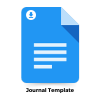Writing Guidlines
The Asian Management and Entrepreneurship Journal (AMEJ) publishes original research articles in the fields of management, entrepreneurship, business, and related disciplines. To ensure the quality and consistency of all published works, authors are required to prepare their manuscripts according to the following comprehensive guidelines. Manuscripts that do not comply may be returned without review.
Before Submission
-
Submissions must be made fully online through the AMEJ website. Authors should register for an account and use their personal dashboard to upload manuscripts, monitor progress, and communicate with the Editorial Team.
-
Authors must ensure that the manuscript:
-
Is original and does not contain plagiarism, falsification, or data fabrication.
-
Has not been published elsewhere and is not under consideration by another journal during the AMEJ review process.
-
Adheres strictly to the AMEJ Author Guidelines.
-
-
Accepted file formats: Microsoft Word (.doc/.docx), OpenOffice, RTF, or WordPerfect. Submissions in PDF will not be accepted.
General Formatting Requirements
-
File Format: Microsoft Word (.doc/.docx).
-
Paper Size: A4 (21 cm × 29.7 cm).
-
Margins: 25 mm (top, bottom, left, right).
-
Font: Times New Roman, 10–12 pt, single-spaced, justified alignment.
-
Length: Manuscripts must be between 6–11 pages, including references. Longer manuscripts may be considered if they provide significant scholarly contributions.
-
Headings: Use an Arabic numbering system (1, 1.1, 1.1.1). Headings should be concise, clear, and informative.
-
Language: Manuscripts must be written in Bahasa Indonesia in a professional and academic tone. Abstracts are required in both Bahasa Indonesia and English.
Title and Author Information
-
Title:
-
Concise, specific, and informative.
-
Maximum 15 words.
-
Times New Roman, 14 pt, bold, sentence case, centered.
-
-
Author Names: Written in full, without academic titles (e.g., “First Author, Second Author”).
-
Affiliations: Include department, faculty, institution/university, city, and country.
-
Corresponding Author: Include email address of the corresponding author.
Abstract and Keywords
-
Abstract:
-
Written in both English (max. 200 words, italicized) and Indonesian (max. 200 words, regular font).
-
Must be in a single paragraph, without subheadings.
-
Content includes: background, objectives, methods, results, and conclusions.
-
Font: Times New Roman, 10 pt, single-spaced.
-
-
Keywords:
-
3–5 terms that accurately reflect the core concepts or variables of the article.
-
Written in both Indonesian and English.
-
Listed alphabetically, separated by commas.
-
Manuscript Structure
The manuscript should be organized in the following sections:
-
Pendahuluan (Introduction)
-
Outlines the background, significance of the problem, and context of the research.
-
Highlights relevant literature to identify the research gap.
-
States the objectives and contributions of the study.
-
-
Tinjauan Pustaka (Literature Review)
-
Presents the theoretical foundation and key concepts.
-
Reviews prior empirical studies relevant to the research.
-
Identifies inconsistencies, gaps, or limitations in past studies.
-
Develops the research framework and hypotheses (if applicable).
-
-
Metode Penelitian (Research Method)
-
Describes the research design and approach.
-
Explains the population, sample, and sampling techniques.
-
Details data collection instruments and procedures.
-
Describes methods of analysis (statistical, qualitative, or mixed).
-
-
Hasil dan Pembahasan (Results and Discussion)
-
Presents results systematically and clearly.
-
Uses tables and figures only as needed to clarify findings.
-
Discusses findings critically by linking them to theories, previous research, and empirical evidence.
-
Highlights novelty, contributions, and implications of the research.
-
-
Kesimpulan (Conclusion)
-
Summarizes the main findings and contributions.
-
States limitations of the study.
-
Provides recommendations for theory, practice, and future research.
-
-
Daftar Pustaka (References)
-
All references must follow APA Style (7th edition).
-
Only include references cited in the text.
-
References
-
A minimum of 10 relevant sources from the last 5 years is required.
-
At least 80% must be primary sources (journal articles, conference proceedings).
-
References must be consistent with APA Style (7th edition).
-
The use of reference managers such as Mendeley, Zotero, or EndNote is strongly recommended.
Examples:
-
Journal Article:
Akita, T., & Alisjahbana, A. S. (2002). Regional income inequality in Indonesia and the initial impact of the economic crisis. Bulletin of Indonesian Economic Studies, 38(2), 201–222. https://doi.org/10.1080/000749102320145057 -
Thesis/Dissertation:
Sunarcahya, P. (2008). Analisis pengaruh faktor-faktor individu dan iklim organisasi terhadap kinerja karyawan (Master’s thesis, Universitas Diponegoro). https://doi.org/xx.xxxx/xx -
Book:
Kotler, P., & Keller, K. L. (2016). Marketing management (15th ed.). Pearson. -
Book Chapter:
Eisenhardt, K. M., & Martin, J. A. (2000). Dynamic capabilities: What are they? In R. A. Burgelman, A. S. Grove, & P. R. Lawrence (Eds.), Strategic management: Concepts and cases (pp. 110–135). McGraw-Hill. -
Conference Proceedings:
Author, A. A. (Year). Title of the paper. In Proceedings of the [Conference Name] (pp. xx–xx). Publisher.








